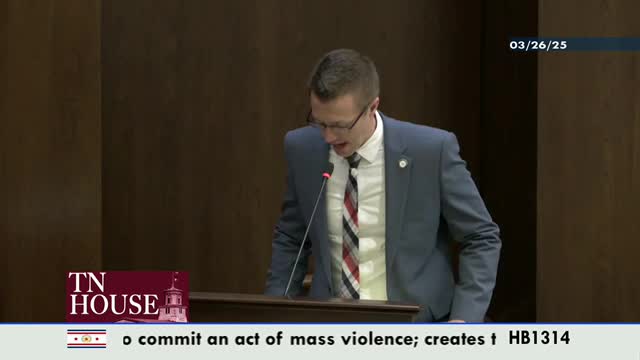Tennessee House Bill 1314 targets threats of mass violence with stricter penalties
March 26, 2025 | Judiciary, House of Representatives, Committees, Legislative, Tennessee
This article was created by AI summarizing key points discussed. AI makes mistakes, so for full details and context, please refer to the video of the full meeting. Please report any errors so we can fix them. Report an error »

In a pivotal meeting of the Tennessee State Legislature's Judiciary Committee on March 26, 2025, lawmakers engaged in a heated discussion surrounding House Bill 1314, a proposed measure aimed at criminalizing threats of violence intended to instill terror. The bill seeks to deter potential acts of terrorism by imposing serious legal consequences, including class E felony charges for general threats and class D felony charges for threats directed at schools, places of worship, or public performances.
As the meeting unfolded, Representative Powell raised a pressing concern regarding the implications of the bill for juveniles. He referenced a recent incident in Nashville where a student was dared to make a threat against a school, questioning whether the instigator would also face legal repercussions under the new legislation. The response highlighted the complexities of the law, suggesting that various charges could apply depending on the circumstances, but it remained unclear how the bill would specifically address such scenarios.
Representative Johnson echoed concerns about the bill's application to young people, emphasizing the need for careful consideration of the different levels of understanding and accountability among minors. She pointed out that while the bill includes provisions for juveniles, the legal thresholds for culpability might not adequately reflect the realities of youth behavior. The discussion revealed a tension between ensuring public safety and recognizing the developmental differences in young individuals.
Leader Cochran defended the bill, asserting that the legal standard of "knowingly" threatening violence would prevent the prosecution of those who make flippant comments or lack the mental capacity to understand their actions. He argued that the bill's intent is to take all threats seriously, especially in light of tragic incidents in schools, such as the recent loss of a student at Antioch High School due to a prior unaddressed threat.
As the committee deliberated, the urgency of addressing threats in schools and public spaces became a focal point, with members acknowledging the delicate balance between protecting communities and ensuring fair treatment for young offenders. The discussions underscored the complexities of legislating in a world where threats of violence are increasingly prevalent, leaving many to ponder the implications of such laws on both safety and justice.
As the meeting unfolded, Representative Powell raised a pressing concern regarding the implications of the bill for juveniles. He referenced a recent incident in Nashville where a student was dared to make a threat against a school, questioning whether the instigator would also face legal repercussions under the new legislation. The response highlighted the complexities of the law, suggesting that various charges could apply depending on the circumstances, but it remained unclear how the bill would specifically address such scenarios.
Representative Johnson echoed concerns about the bill's application to young people, emphasizing the need for careful consideration of the different levels of understanding and accountability among minors. She pointed out that while the bill includes provisions for juveniles, the legal thresholds for culpability might not adequately reflect the realities of youth behavior. The discussion revealed a tension between ensuring public safety and recognizing the developmental differences in young individuals.
Leader Cochran defended the bill, asserting that the legal standard of "knowingly" threatening violence would prevent the prosecution of those who make flippant comments or lack the mental capacity to understand their actions. He argued that the bill's intent is to take all threats seriously, especially in light of tragic incidents in schools, such as the recent loss of a student at Antioch High School due to a prior unaddressed threat.
As the committee deliberated, the urgency of addressing threats in schools and public spaces became a focal point, with members acknowledging the delicate balance between protecting communities and ensuring fair treatment for young offenders. The discussions underscored the complexities of legislating in a world where threats of violence are increasingly prevalent, leaving many to ponder the implications of such laws on both safety and justice.
View full meeting
This article is based on a recent meeting—watch the full video and explore the complete transcript for deeper insights into the discussion.
View full meeting
